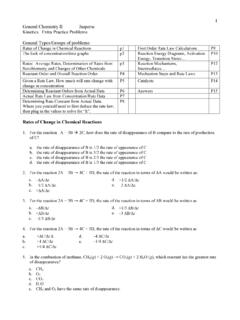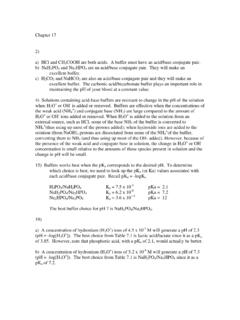How To Determine Orders Of Reaction
Found 8 free book(s)Experiment 1 The Iodine “Clock” Reaction
proffenyes.weebly.comm is the Reaction Order with respect to Reactant A, and n: is the Reaction Order with respect to Reactant B. The values of the reaction orders (“m” and “n”) determine the dependence of the reaction rate on concentration of the respective reactants. Reaction orders commonly have one of the following values: 0, 1, -1, or 0.5.
EXPERIMENT 13: THE IODINE CLOCK REACTION
intro.chem.okstate.eduThis can be done to determine the order of the reaction between I– and S2O82–. From your plots (attach your graphs) determine the order of the reactions with respect to I– and S2O82–. Once the orders are determined use the rate law to determine the rate constant for each of experiments. Exp. # [I–] added [S2O82–] rate rate constant ...
ORDER OF REACTION - PharmaQuesT
pharmaquest.weebly.comMETHODS TO DETERMINE ORDER OF REACTION 1. SUBSTITUTION METHOD 2. INITIAL RATE METHOD 3. DATA PLOTTING METHOD 4. HALF-LIFE DETERMINATION METHOD SUBSTITUTION METHOD: The data accumulated in a kinetic study may be substituted in the integrated form of the equations which describes the various orders. When the equation is …
TIPS, TRICKS & BEST PRACTICES The Ultimate qPCR Assay ...
www.bio-rad.comreaction conditions. How to avoid Always validate a new qPCR assay to verify its efficiency under your specific conditions • Determine efficiency using a standard curve spanning 5 orders of magnitude (5- or 10-fold dilutions) and run in triplicate to determine the efficiency, linear dynamic range, and reproducibility of the assay
Test1 ch15 Kinetics Practice Problems
web.mnstate.edu6 Determining Reactant Orders from Actual Data 23. Given the following data, determine the order of the reaction with respect to Cl 2. 2NO(g) + Cl2(g) → 2NOCl(g) Experiment [NO] (M) [Cl 2] (M) Rate (M/s) 1 0.0300 0.0100 3.4 × 10–4 2 –0.0150 0.0100 8.5 × …
Chapter 8, Acid-base equilibria - bu.edu
www.bu.edureaction of the acid and base as a limiting reagent problem, but then equilibration of the products is ... this road map of acid-base equilibria when you approach such an equilibrium as a two step process: First (always!), determine which regime applies. Then, ... (orders of magnitude), and so it is convenient to measure [H3O
Chapter 17
websites.umich.eduorders of magnitude in [H3O +]. Part 2. Calculate the pH change upon adding 10.0 mL 0.10 M NaOH to 90 mL buffer containing 1.0 M NH3 and 1.0 M NH4Cl. The key reaction with the buffer will be: NH4 + + OH-Æ H 2O + NH3 The strong base will react with the ammonium cation in the buffer and completely convert it to ammonia. The number of moles of ...
Sample Exercise 14.1 Calculating an Average Rate of Reaction
www.austincc.eduThe overall reaction order is the sum of the exponents in the rate law. The units for the rate constant, k, are found by using the normal units for rate (M /s) and concentration (M) in the rate law and applying algebra to solve for . k. Solve: (a) The rate of the reaction in Equation 14.9 is first order in N. 2. O. 5. and first order overall ...







